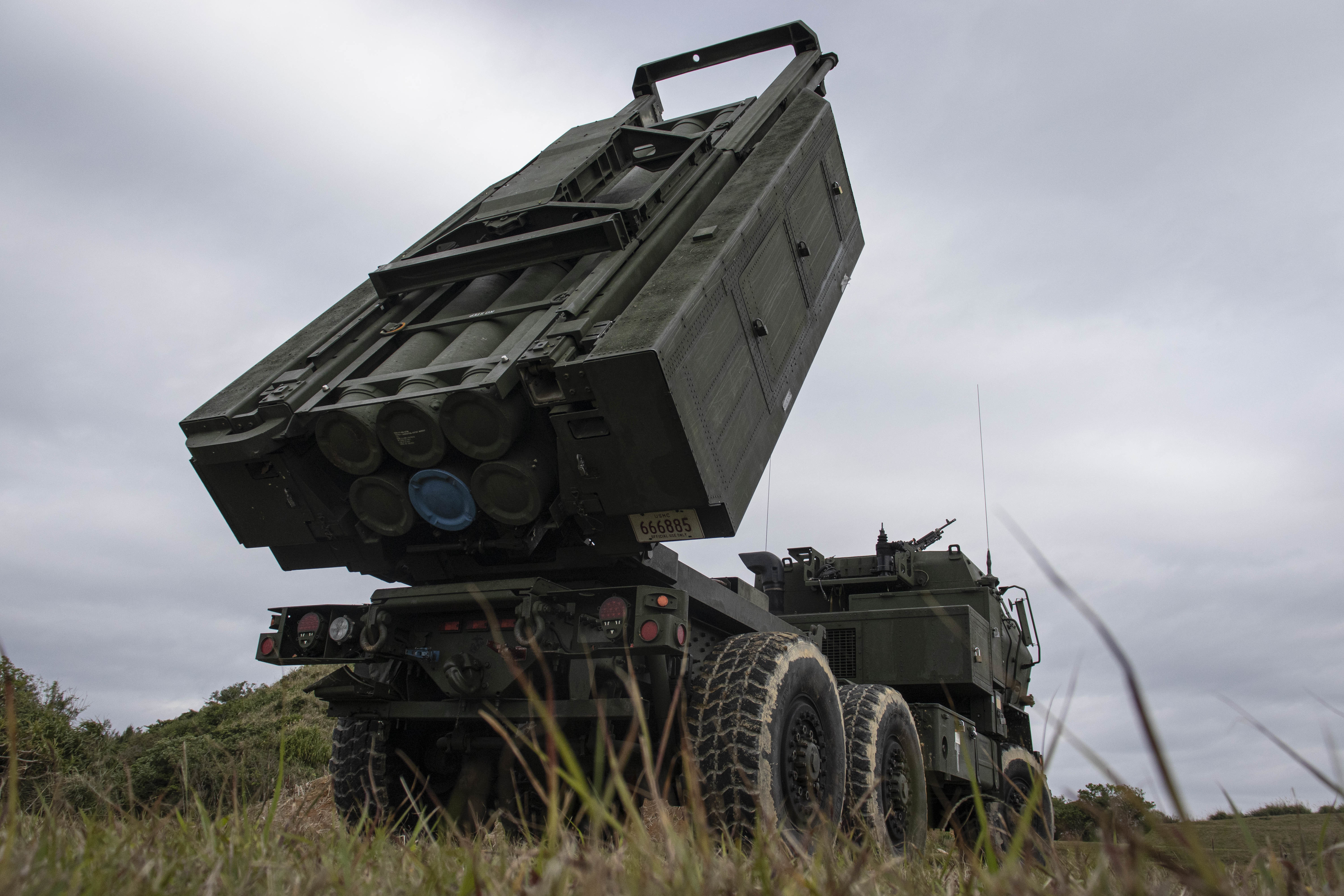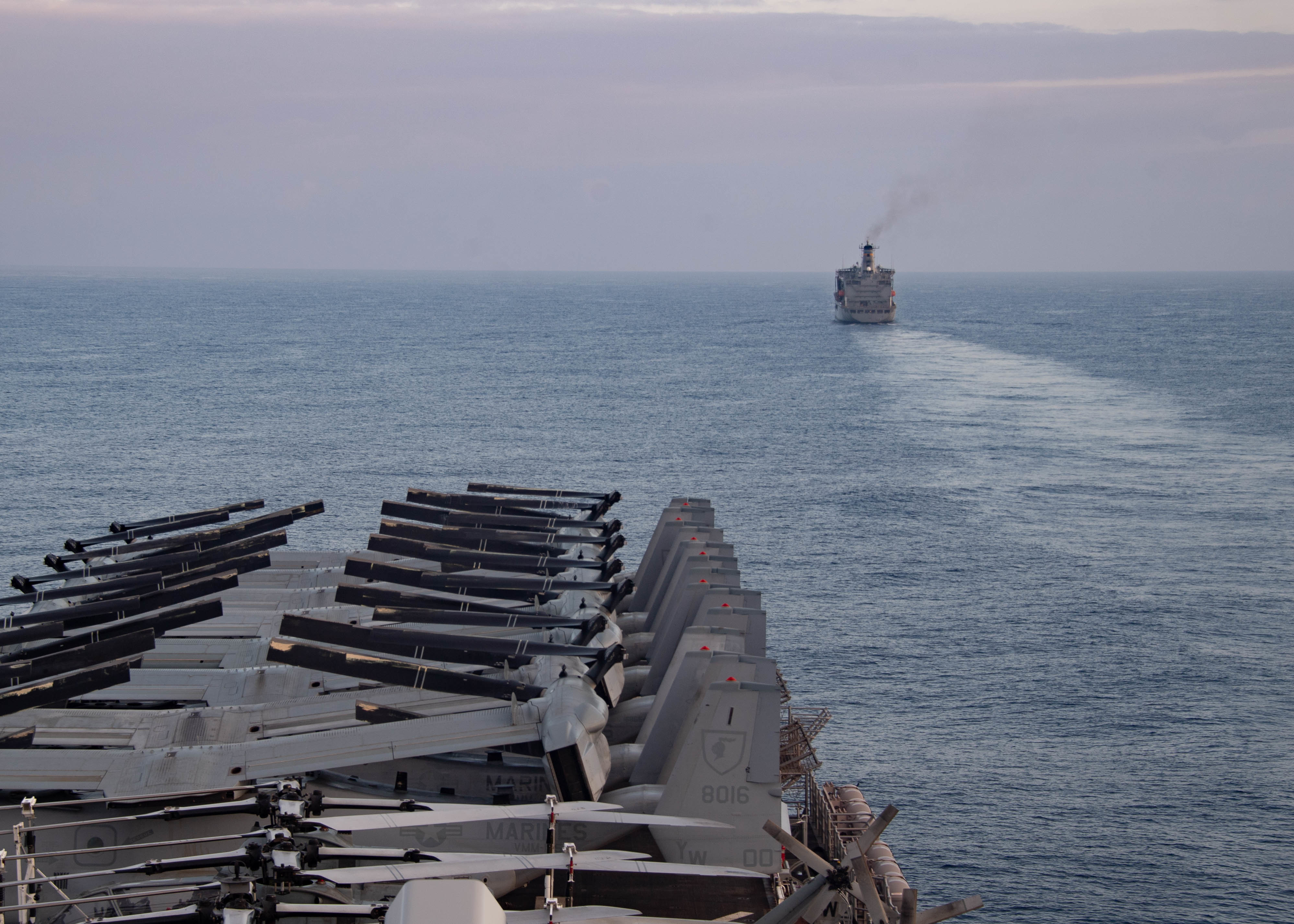Navy, Marines Drill with Japanese Forces in Test of New Island-Hopping Concept
Ships of the America and Essex Amphibious Ready Groups, and Abraham Lincoln Carrier Strike Group, sail in formation with the Japan Maritime Self-Defense Force during exercise Noble Fusion on Feb. 7, 2022. US Navy Photo
The U.S. Marine Corps, U.S. Navy and Japanese Self-Defense Force teamed up in the Philippine and East China seas to test the ideas behind the Marines’ Force Design 2030 plan.
Noble Fusion, held in early February, tested the Marines’ island-hopping concept with allies.
“Noble Fusion allowed us to showcase our interoperability and to validate Force Design 2030 initiatives in our Corps’ main-effort theatre at a scale not seen since 2018,” Col. Michael Nakonieczny, commanding officer of the 31st Marine Expeditionary Unit, told reporters.
The exercise “set conditions for the next large-scale exercise that will allow us to rehearse our response to any crisis or conflict, at an ever increasing scale.”
The drills serve as a prelude to a larger scale exercise between U.S and Japanese forces scheduled to take place in Japan later this year.
Navy Capt. Greg Baker, Commodore of Amphibious Squadron 11, said that he and Nakonieczny were studying how their forces would operate and use their personnel and equipment in unique ways. “We’ll try different things, we’ll try different ways of employing the equipment that we have, of employing the personnel that we have and mixing our teams up as best as we can,” he said, giving the example of Marine personnel working together with Navy systems and vice versa, both ashore and at sea.

A U.S. Marine Corps High Mobility Artillery Rocket System with 31st Marine Expeditionary Unit (MEU), rehearses a firing mission during a security screen at Kin Blue, Okinawa, Japan, Feb. 9, 2022. US Marine Corps Photo
One area is exploration is fires integration, not only between Navy and Marine Corps units and assets, but also with partner nations. During Noble Fusion, Commander Task Force 76, the Japan Maritime Self-Defense Force (JMSDF) destroyer JS Kongo (DDG-173), 31st MEU Marines operating from a simulated Expeditionary Advanced Base and aircraft from carrier USS Abraham Lincoln (CVN-72) participated in a simulated practice strike.
USS Dewey (DDG-105) was assigned as the oppositional force for the simulated strike while an E-2D Hawkeye from Abraham Lincoln served as the Maritime Air Controller. A P-8A Poseidon, assigned to Task Force 72, provided real-time targeting data to Kongo, the EAB, and F/A-18E Super Hornets that launched from Abraham Lincoln. Baker said that the land-based EAB served an extension of the naval forces. In conjunction with the new Marine warfare concept, the EABs are designed to be quickly assembled ground bases that serve as a sensor and a rearming, refueling and resupply node for allied forces, as well as a launching point for strikes.
“We could treat that EAB essentially like a destroyer. We could find a maritime target to go after and we could have multiple units engage that target from a destroyer or do that from an EAB by passing targeting data, as well as aircraft from land or ships. The ability to strike in the maritime is strengthened by the EAB,” Baker said.
Another use of the EABs was as refueling assets. “We’ve worked with not just refueling Marine Corps assets, but we’ve also worked with refueling joint assets and we’ve been working towards expanding that capability,” Baker said. During Noble Fusion, 11th MEU Marines from amphibious warship USS Essex (LHD-2) refueled a P-8A Poseidon in a simulated foward landing zone at Marine Corps Air Station Futenma, Okinawa.
Wasp-class amphibious assault ship USS Essex (LHD 2), left, transits the Philippine Sea with fleet replenishment oiler USNS Yukon (T-AO 202) in support of Noble Fusion, Feb. 4, 2022. U.S. Navy PhotoCol. Michael Brennan, the operations officer for 3rd Marine Expeditionary Brigade, told USNI News separately that the participation of the Abraham Lincoln Carrier Strike Group in Noble Fusion presented an opportunity for CSG 3 and the Amphibious Ready Groups/Marine Expeditionary Units to work together to rehearse a distributed command and control architecture from multiple locations, as well as coordinate aviation operations across hundreds of miles of littoral geography in the first island chain.
Lessons learned from Noble Fusion included better understanding of the coordination required to operate two MEUs/ARGs alongside a CSG at sea, how to integrate aviation operations, how to synchronize aviation strikes involving multiple multi-domain platforms, how to coordinate the defense of the amphibious task force with a carrier strike group and JMSDF assets, and how to integrate U.S. Air Force assets along with Navy and Marine Corps aviation elements.
Expeditionary Sea Base USS Miguel Keith (ESB-5), which is currently serving as the command platform for CTF 76 and Expeditionary Strike Group 7, also participated in the exercise. The Navy has been experimenting in recent years with the use of alternate command ship platforms in the Indo-Pacific, other than the lead ships of its task groups and USS Blue Ridge (LCC-19). But these experimentations geared toward specific focus missions, like the use of the Expeditionary Fast Transports for operations and engagements with regional nations. During Noble Fusion, Miguel Keith also served as a training platform for visit board, search and seizure (VBSS) training by 31st MEU Marines.
During the exercise, CTF76/ESG7 executed command and control of the composite task force from Miguel Keith. Mine Countermeasures Squadron 7 and Naval Special Warfare groups have also used Miguel Keith for command and control while in the U.S. 7th Fleet area of operations.
During the call, officials said a larger exercise between U.S. and Japanese forces, called Maritime Defense Exercise-Amphibious Rapid Deployment Brigade (MDX – ARDB) will take place later this year in Japan. Both Nakonieczny and Baker declined to confirm specific dates for the drills, but said they were looking foward to the exercise, which would be on a much larger scale than Noble Fusion and enable them to further develop joint operations with Japan’s military.
“I want more exercises and more capabilities added and involved to these exercises,” said Nakonieczny.

![DVIDS – Images – U.S. Army Golden Knights drop in to 2025 Army Navy Game [Image 7 of 10] DVIDS – Images – U.S. Army Golden Knights drop in to 2025 Army Navy Game [Image 7 of 10]](https://101veterans.com/wp-content/uploads/2024/12/dvids_logo_20_main.png)